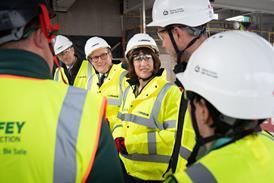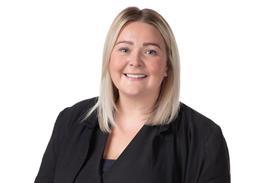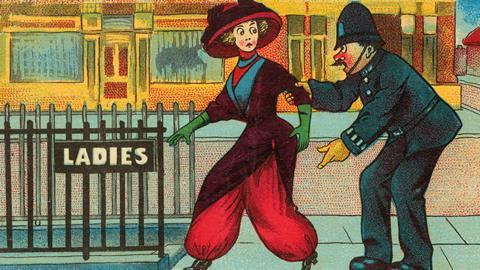Women were admitted to the profession a century ago but the Law Society was slow to provide them with their own facilities, writes Eduardo Reyes. A fascinating new book on legal landmarks between the wars recounts how it took a highly symbolic special general meeting to force Chancery Lane’s hand
‘Everybody’s got a bathroom story, haven’t they,’ Lady Hale told fellow jurist US Supreme Court justice Ruth Bader Ginsburg in 2008. Bader Ginsburg told their audience at the Georgetown University Law Centre about the creation of a ‘women’s bathroom’ by the US Supreme Court’s robing room shortly after she arrived in 1993. The US court’s first woman justice, Sandra Day O’Connor, had a longer walk to worse facilities.
Hale’s arrival as the first woman justice at the Privy Council, appeal court for Crown dependencies and several Commonwealth countries, heralded its first women’s toilet, in 1999.
These are among the stories I found while researching the Law Society’s head office on Chancery Lane – its ‘Hall’ (see below).
After legislation and a change in Law Society and Bar Council policies allowed women to join the legal professions in 1919, the Society dragged its feet on the practical basics – including the provision of ‘women’s lavatory accommodation’.
In the event, it took the noisy intervention of a woman law student’s solicitor father to deliver the facilities. But what was then created was far in excess of the immediate need and was decades ahead of provision elsewhere in the law.
Preserving masculine seclusion
Did this matter? Absolutely – and the significance is in both the practical and symbolic importance of these facilities. The episode also tells us a great deal about women’s entry into the profession and the obstacles they faced.
After 1919, the women entering the profession should have been claiming the spaces associated with their newfound professional status. Yet contemporary reports in the Gazette and Solicitors Journal (SJ) make clear this was not happening.
'There are privacies of mess life which render it inconvenient to mix the sexes'
Solicitors Journal, 1922
In 1923, the Bar Mess at the Old Bailey held a general meeting to discuss its first female application for membership. She was turned down, due to ‘unforeseen difficulties, arising from the nature of the Mess premises’, which ‘had shown themselves in the way of admitting women to the Mess’.
Regional and circuit messes were also failing to open up. ‘There are privacies of mess life which render it inconvenient to mix the sexes,’ SJ noted in 1922. In light of which, ‘the general scheme seems to be the admission of women with full rights of membership, but without the right to attend mess… In this way women receive all the usual benefits as regards notice of sittings, postal arrangements, attendance in court, court briefs, admission to the poor persons’ defence list, and the like; while the seclusion of the masculine mess is preserved’.
Women could find hotels on the circuit to form their own mess, SJ concluded.
Such prim justifications for discrimination continued for decades. Hilary Heilbron KC, daughter of the first senior woman judge Rose Heilbron KC, was called to the bar in 1971. She recalls the lack of toilet facilities being used as a reason to exclude women from some chambers on the eve of the Sex Discrimination Act 1975.
Our Hall
We now seldom describe the Law Society’s Chancery Lane headquarters as its ‘Hall’, but a century ago the designation was common. And the idea of a community’s hall has an importance stretching back to Beowulf’s hall, Heorot. It is where a community’s actors come or are called to meet, feast, make decisions and choose leaders. For these reasons the Inns have halls; Cambridge colleges have halls; the Vicar of Dibley has a parish hall.
And in the early 20th century, the Law Society’s Hall was in full use for such purposes – the location not just for ceremony, but also for teaching, study, examination and professional encounters. Its frequent dinners were populated by a vast cast who knew each other well.
The Law Society was, just about, doing better than the circuit messes. An ‘interim measure’ was in place, whereby women could use a lavatory in the president’s office complex on the third floor.
But permanent, adequate, convenient arrangements would signal equality and professional respect. And, even before the admission of the first woman solicitor Carrie Morrison, that is what law students were asking for through the Society’s student committee, and failing to get.
As with women’s entry into the profession, to make progress women would need professionally established men to speak for them.
Before 1919, the men who spoke for women’s equality had been well organised and had close networks with the women with whom they had made common cause.
But post-1919 there was a problem. The tightly organised networks that had worked to deliver votes for women and open up the profession dissipated when these were achieved. There was no immediate, obvious goal on which to focus. And although the number of women was slowly increasing, they were still small in number and their junior status carried little weight.
There is no record of the individuals who served on the Law Society’s student committee, but it clearly included men who saw the importance of permanent lavatory provision for women. From 1919 the committee was asking for the Society to act.
Without further delay
The need for women’s lavatories was accepted in principle but no action was taken. Women students, and male supporters, became impatient. Things came to a head in 1922. On 23 December, members were informed: ‘A Special General Meeting of the members of the Society will be held in the Hall of the Society, on Friday, the 26 January, at 2 o’clock.’ Two topics were on the agenda and first up was the issue of the loos.
In the 1920s, it took 20 solicitors to call a special meeting, and the quorum for the meeting to proceed was also 20. The man who organised this group was London solicitor Percy Chambers. He needed to organise known male supporters of women in the profession to get his meeting.
Why Chambers? First, his daughter Katharine Elizabeth was a law student and, with Carrie Morrison, a founding member of the 1919 Club, forerunner of the Association of Women Solicitors. Katharine would later be articled to her father. While his son had been killed in the first world war, Chambers’ belief in equality went further than a succession issue for his practice. He gave articles to at least one other woman and encouraged others professionally.
At the meeting, Chambers rose and asked whether Council intended to provide women with ‘suitable separate cloak-room and lavatory accommodation notwithstanding they have hitherto refused to grant such accommodation to the women students’. And he proposed a motion stating the ‘imperative’ of providing the accommodation ‘without further delay… and that the Council be required… to take immediate steps’.
To his surprise, the Law Society president Arthur Copson Peake agreed. He said the Council ‘intend to provide them with suitable cloakroom and lavatory accommodation… This matter had been receiving the consideration of a committee of the council for several weeks. Plans had been now passed which would entail a considerable amount of expense’.
The House Committee had already been tasked with considering ‘women members and students. Additional cloak-room and lavatory accommodation’, and would report to the Council within weeks.
Wrongfooted, Chambers withdrew his motion. ‘In justification to himself,’ Chambers said, ‘the matter had been before the Council not only for the last three weeks but for the last three or four years; because the students’ committee had during the past three years made recommendations that the question should be attended to.’
But why was Chambers surprised by the committee’s work? It is speculation, but if the provision of women’s cloakroom and lavatory facilities had not been a priority, the prospect of the passing of a critical motion at a special meeting, called not by the Council but at the behest of a well-organised and respected group (Chambers was a City and commercial solicitor), may have spurred the Society’s senior officers, including its president, to act – and to do so in a way that put Chambers in his place.
The resolution of a special meeting was not binding on the Law Society until adopted by the Council, but the Council was bound to adopt or bring the matter to the next Society general meeting. If the matter became drawn out, it could embarrass the Society through the sort of publicity that had attached to other episodes involving women solicitors.
Certainly, the House Committee and the Society’s architect were working at speed. We know this because the works described by Peake at the special meeting were quite different from those recommended by the House Committee and adopted by Council a few weeks later on 16 February. The House Committee’s report noted the admission of ‘one woman’ solicitor, meaning it was working on its report after Carrie Morrison’s admission on 18 December and as a date was being set for the special meeting.
The full set of works proposed by the committee and approved by Council was for the creation of four lavatories, each with an attached room ‘for the exclusive use of women’. The first set, for ‘women members’, would displace the members’ cloakroom, moving it to the right-hand side of the Chancery Lane entrance; a prestigious location, opening on to the main entrance hall. The second set, for women students, would convert a groundfloor room used by the president. A third set on the second floor, also for women students, would displace ‘the existing coal store’, with a new coal store being constructed ‘on the outside roof of the same floor’. And finally, there was a fourth set, ‘for the accommodation of women attending the Society’s examinations’. The cost was the equivalent of £56,000 today.
Future demand
Why did the House Committee recommend changes on this scale? At this point, there had been no more than 11 women in the building at any one time. Perhaps this was a case of professional status, and a sense of hierarchical propriety, trumping other considerations. Perhaps a solicitor could not be expected to share facilities with students and examination candidates. (Questions of respectability led many women to shun London’s few subterranean public lavatories, pictured.)
By the Law Society AGM on 25 July 1924, the works were complete. The Society’s grandly titled ‘Chancellor of the Exchequer’ Mr Hickley observed that ‘the item “buildings and repairs” showed a heavy increase, but this was due to the adaptation of the Society’s buildings to the use of lady solicitors’.
While he had superintended the expenditure, he marked the moment by reaching for patronising levity: ‘Whether or no the fair sex would eventually take possession of the building and leave mere males to find accommodation elsewhere remained to be proved; but at the moment there did not seem any probability of such an event taking place during his term of office.’
It is not recorded whether Hickley’s humour earned him a laugh from those present. But by replacing the makeshift arrangement of women’s access to the president’s third-floor lavatory and creating spaces for women, the Society had built a degree of equality into the physical architecture of the profession at its Hall.
In this regard, the Society was ahead of other legal sector organisations, in some cases by more than half a century. Moreover, though it had taken four years to achieve, once the House Committee was tasked with recommending facilities, its hand apparently forced by Chambers – father of a 1919 Club founding member – its recommendations were of a scale that anticipated future demand.
Women’s Legal Landmarks in the Interwar Period – Not For Want of Trying, editors Auchmuty, Rackley and Takayanagi, is published by Bloomsbury. The chapter ‘Women’s Lavatory Accommodation at the Law Society, 1923’ can be read here.
Listen to Eduardo Reyes on Women’s Legal Landmarks' podcast 'Not for Want of Trying' here






























1 Reader's comment